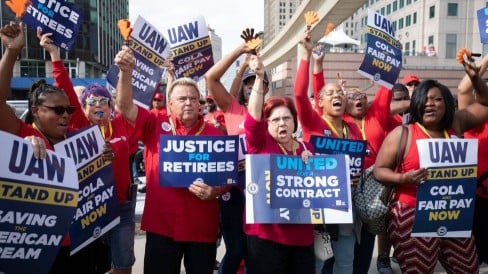
The United Auto Workers (UAW) union has declared a strike targeting Ford, General Motors and Stellantis, in a bid to put pressure on the carmakers to grant higher pay and make other improvements in new labour agreements.
It comes at a time of broader labour unrest and casts a cloud of uncertainty over an industry that accounts for 3% of the national economy.
US President Joe Biden has been forced to weigh in on the dispute, which is playing out in states that have disproportionate importance in national elections.
What is the UAW?
The UAW was founded in 1935 to represent workers at America's motor giants: Ford, GM and Chrysler - now part of Stellantis.
It was a hugely powerful force in US politics after World War Two, at a time when those companies were the world's pre-eminent car giants and manufacturing jobs in the motor industry were seen as a path to the middle class.
UAW membership peaked in 1979 at almost 1.5 million.
Today, it represents more than 400,000 active workers across a wide range of sectors, including hospitals and universities, including more than 140,000 members who work at Ford, GM and Stellantis.
This is the first strike in the UAW's 88-year history to target all three companies - known as the Detroit Three - at once.
The action is the brainchild of Shawn Fain, a fiery former electrician in the industry who was narrowly elected this spring promising a more transparent and combative approach to contract negotiations.
Image source, Getty Images
His win followed an embezzlement scandal at the union.
Where is the strike happening?
The work stoppage started on 15 September at three factories, which together employed about 12,700 workers.
They were:
- a GM assembly plant in Wentzville, Missouri that works on GMC Canyon and Chevrolet Colorado midsize pickups, as well as the GMC Savana and Chevrolet Express full-size vans
- a Ford site in Wayne, Michigan that works on Bronco SUVs and Ranger midsize pickup trucks
- a Stellantis site in Toledo, Ohio that works on Jeep Wranglers and Gladiator pickups
A week later, the UAW expanded the walkout to 38 parts distribution centres at General Motors and Stellantis, asking roughly 5,600 more workers to participate in stoppages.
The three companies account for roughly 40% of car sales. These shutdowns affect a small fraction of their production.
But with inventories sitting at relatively low levels, analysts have warned that a prolonged stoppage could still lead to higher prices for buyers.
What are the UAW demands?
The walkout began after the expiration of 2019 labour contracts between the union and three companies on 14 September.
The two sides are negotiating over issues such as pay, days off and cost of living adjustments,as well as systems that pay newer and "temporary" hires less for comparable work.
UAW president Shawn Fain has cast the fight as part of a broader battle over economic justice and the billionaire class.
The UAW opened negotiations seeking a 40% pay rise over the four years of the contract.
The union has rebuffed claims that the figure is outlandish, noting double-digit jumps in the pay packages for company bosses, a surge in profits - and money the companies have spent buying their own shares - as well as decades of declining pay power in the industry, including in recent years, when prices surged.
The chief executives of all three companies had pay packages last year worth more than $20m.
The fight also comes as the industry is investing heavily in electric vehicles. The union is worried about that shift, since producing such cars requires fewer workers and currently involves non-union labour.
What is the latest update on the negotiations?
GM boss Mary Barra said the union's initial demands amounted to $100bn in costs. Ford chief Jim Farley said they would drive his firm to bankruptcy.
The car companies face fierce competition from the likes of Toyota and Tesla, which do not have unionised workforces and enjoy lower labour costs. The Detroit Three are also under pressure to spend heavily on electric vehicle investments.
The UAW reduced its pay demands to a 36% rise, but the car companies maintain its requests are still too onerous. Their recent counter-offers include raises of roughly 20%.
They have also already announced temporary layoffs for thousands of other staff whose work depends on the striking factories.
Mr Fain has said talks are progressing at Ford, which he said had signed off on pay increases tied to inflation among other demands. He said talks appeared at an impasse with the other two companies.
Former President Donald Trump, who is running for re-election, is reportedly planning a trip to Detroit next week to address auto workers.
How long will this last?
The last time the UAW went on strike, against GM during 2019 negotiations, the walkout lasted six weeks.
The UAW has $825m on hand to support workers participating in the strike, enough to last about two months with all members participating.
The decision to take targeted action is aimed generating uncertainty for the car companies and at preserving that fund - and limiting the pain felt by workers, who are eligible for $500 a week from the union, less than typical wages.






